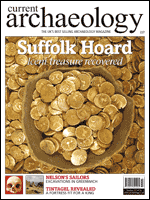 With winter solstice finally behind us and the Spring equinox edging ever nearer, we visit the Scottish island of Foula. Remote and battered by gales, the tiny island boasts a double ring of stones deliberately positioned by Bronze Age sky-gazers to herald the rising sun of the winter solstice. Another craggy island, Tintagel, is famed for its connection with King Arthur and his Knights of the Round Table. Could a great king really have lived on this rocky headland?
With winter solstice finally behind us and the Spring equinox edging ever nearer, we visit the Scottish island of Foula. Remote and battered by gales, the tiny island boasts a double ring of stones deliberately positioned by Bronze Age sky-gazers to herald the rising sun of the winter solstice. Another craggy island, Tintagel, is famed for its connection with King Arthur and his Knights of the Round Table. Could a great king really have lived on this rocky headland?
For King and Country: the skeletal remains of veterans buried in the Royal Greenwich Hospital cemetery tell a grim story of life and death in Nelson’s navy. In contrast, the luxurious lifestyle of less reputable mariners is reflected by pirates’ plunder discovered in the unlikely location of London’s East End. Our front cover displays the gleaming treasure of an Iron Age coin hoard discovered by a metal detectorist earlier this year. Current Archaeology brings you this exclusive report on one of the year’s most exciting finds.
SUFFOLK GOLD
A few coins scattered just below the surface of a Suffolk field led a metal detectorist to a Late Iron Age pot of gold. More than 800 gold coins lay in the earthenware vessel, untouched for 2,000 years. CA breaks the news of this incredible new find.
ROYAL HOSPITAL GREENWICH
The skeletal remains of over a hundred veterans from Nelson’s navy have been excavated from the Royal Hospital Greenwich. Their skeletons bear dramatic evidence of disease, malnutrition and injuries – incurred as a result of wounds suffered in battle as well as from the hazardous conditions endured aboard ship.
WHAT IS TINTAGEL?
Enshrouded by myths of King Arthur and set amidst the dramatic North Cornish coastal landscape, Tintagel has captured the public imagination for centuries. Dominated by a 13th century castle, there seemed to be little evidence of any other structures on this craggy island. Could there really once have been a magnificent fortress, one fit for a king of Arthurian stature?
STONES AND SOLSTICES
More than 3,000 years ago, a community of Bronze Age people on Foula, Scotland’s most remote island, erected 290 standing stones, all carefully positioned to observe the movement of the sun at the solstice and the equinox. Did these stones have a practical, rather than a purely ritual, purpose?
POTTERY AND PLUNDER
Exotic ceramics, precious glassware and Cuban silver coins have been found in 16th and 17th century cesspits in the unlikely environment of London’s East End. Luxury items of this nature were sometimes found in rich men’s houses, but this was a rough part of town, home to shipwrights and sailors. Archaeologists believe this could be evidence of pirates’ bounty.
LAST WORD
The Portable Antiquities Scheme survives again
ODD SOCS
The Bastketmakers’ Association and the Scottish Basketmakers’ Circle



